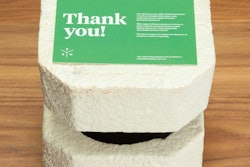In 2010, The Procter & Gamble Company unveiled a long-term environmental sustainability vision centered on Conservation of Resources, Renewable Resources, and Worth from Waste, with aggressive, measurable goals for 2020. To reach these goals, P&G has partnered with several industry organizations to advance the sustainable use of packaging materials throughout the entire life cycle, including raw material development, manufacturing, consumer use, and end of life.
In May 2015, P&G joined the American Chemistry Council’s Flexible Film Recycling Group to develop and encourage the recycling of polyethylene film. In this Q&A article, P&G Research and Development Manager Stephen Sikra discusses how this effort will help advance P&G’s environmental vision, the challenges of recycling PE film, and the importance of film recycling.
Packaging World:
What is your role and what are your responsibilities at P&G?
Stephen Sikra:
I lead P&G’s global Material Science and Technology (MS&T) program for package material innovation. The focus of my work is helping P&G achieve two of its visionary goals: to one day have zero waste—manufacturing and consumer—sent to landfill, and to make all packaging with 100% renewable or recycled materials.
One key area of our R&D efforts is advancing sustainable materials for use in P&G packages and products. This effort spans the full life cycle of our value chain, so we consider raw material development through manufacturing, consumer use, and end of life. To help our understanding of this life-cycle process, we work with and learn from many partners. For example, I work with industry leaders such as the Association of Postconsumer Plastic Recyclers, the recently formed Closed Loop Fund, and now the American Chemistry Council’s Flexible Film Recycling Group to develop and encourage local recycling programs.
Why did you choose to join the FFRG? How do their initiatives fit in with P&G’s goals for recycling?
The FFRG is making positive strides to advance film recycling by bringing stakeholders together with a simple, unified mission: “To significantly increase the collection and recycling of all flexible films and to educate the public about the importance of recycling.” The FFRG is making use of the existing film reclamation infrastructure built around retail stores for collection. We believe increased participation in this mechanism can bring tangible advances to film recycling in the near term. This helps enable multiple goals for P&G, including:
• Using packaging that is recyclable or engaging in programs to create the ability to recycle it. Our goal is to have 90% recyclable packaging or have programs in place to create the ability to recycle it by 2020.
• Contributing to our vision for one day having zero consumer and manufacturing waste to landfill.
• Increasing the supply of material to meet growing PCR demand, such as P&G’s goal of doubling the use of PCR material by 2020.
With the FFRG, we hope to expand participation in film recycling via existing and new retail store take-back programs. Further, we look to partner with FFRG to expand film recycling beyond polyolefin films and store collection.
Can you elaborate on how P&G’s membership in the FFRG will facilitate the company’s goal for zero waste to landfill?
Our vision for zero consumer waste to landfill is more than an aspiration; we are working toward this long-term vision and have set short-term goals to get us there, each with published, measurable results, so we are holding ourselves publically accountable for making solid advances.
When we assess P&G packaging materials under the lens of recycling, we see opportunities to improve high-density polyethylene and PET recycling; P&G has a long history of working with the APR in this space. Along with other like-minded companies, we recently became founding members of the Closed Loop Fund to expand the recycling infrastructure with low-interest loans. With the ACC, the APR, and others, we formed the APR Rigids Committee about six years ago to increase PP recycling, driving a 3X increase in recycled PP.
We see film recycling as another opportunity area and view the FFRG efforts as a meaningful way to advance the cause. We hope this becomes another successful example of industry partners coming together for a common cause. We recognize that to make real progress, our industry will need substantial increases in consumer and commercial recycling. This is a step in the journey. Eventually, I hope to see more advances in curbside film collection. For now, our message is simple, “Take your clean, dry film back to stores for recycling.”
FFRG focuses on the recovery of flexible PE film, wraps, and bags. How much of this type of packaging does P&G use? What is it used for?
P&G is a relatively small film user (by tonnage) compared to the total film market, using films for both shipping and packaging. We use film to contain unit loads of product shipped on pallets within our distribution system. This industrial film is routinely recycled today by our plants and retail customers.
On the consumer side, P&G uses flexible PE film as shelf packaging and unit packaging primarily for items such as diapers, feminine care products, and tissue/towels. We are working to educate and encourage consumers to recycle high-quality polyolefin films in store take-back programs.
Why is the recycling of PE film important?
Film packaging has many benefits versus rigid packaging, including the use of less material to package products, requiring less energy to produce, taking up less space in shipment/storage/retail, and reducing the environmental impacts of transportation. Given the many benefits and the increasing use of film packaging, it is important we work to optimize collection and recovery, as both post-consumer and post-industrial films have value. Maximizing recovery of value is good for business, good for consumers, and good for the environment.
What do you believe are some of the greatest challenges to PE film recycling?
When I consider recycling in general, I view four factors as critical to a successful program: access to collection, participation by consumers, systems for separation of materials, and end markets for the recycled material. I see strong demand for recycled PE film material in both durable goods and films/flexibles. There are challenges—although I prefer to call them “opportunities”—including access, participation, and separation. Importantly, we know most curbside systems are not equipped to handle film; it can jam municipal recycling facility (MRF) equipment that is not designed for film handling, and separation/identification systems are not in place for film. Because of this, the message to most U.S. consumers is, “Don’t put films in your recycling bin.” So a lot of work needs to be done to make curbside film recycling effective, including education and outreach to infrastructure investments. Along our journey, making use of the best current systems, such as store take-back programs (and the few curbside programs that do exist) makes sense.
Considering film recycling in the retail take-back system, consumer awareness and participation is a key focus area. The 2014 survey by Plastics Make it Possible® indicates that of the two-thirds of Americans who regularly recycle, less than one-third return plastic shopping bags to stores for recycling (so less than 25%). We aim to increase this rate and expand the collection beyond bags by including packaging materials made of similar clean, dry, polyolefin film. In this effort, we look to make use of the How2Recycle label from GreenBlue’s Sustainable Packaging Coalition (SPC) as a simple means to communicate recyclability to consumers.
One of P&G’s stated sustainability goals is to double the use of recycled resin in your plastic packaging. Can P&G use recycled PE for new packaging?
P&G can and does use recycled PE in our packaging. In fact, we have been using recycled PE (and PET) since the late 1980s. Our main use of plastic PCR material is in bottles, although we have demonstrated PCR use in films as well. Our 25-year history of using PCR—25% or more in all U.S. detergent and fabric softener bottles, for example—and our recently announced goal of doubling our PCR use by 2020 is indicative of our commitment to the recycling industry. Simply, we use PCR, and we are in it for the long haul. Specific to new packaging, consideration of PCR inclusion and recycling is made in every situation; this is part of sustainable packaging design, along with performance requirements and product protection, material selection, minimization of material, cost, supply, and other factors.
As far as demand for recycled PE film, I see it as very strong with many uses, including durable goods such as composite lumber for decks, fencing, building and garden products, crates, and piping, and for flexible applications, including new film packaging and plastic bags.

























